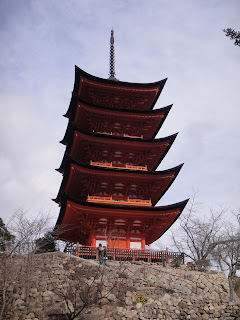We tracked down the source of our new traffic: an article written about our trip to Koyasan. The best we can do is provide the Google translation for our English readers, but we encourage you to visit the actual article if you can read Japanese. (http://news.searchina.ne.jp/disp.cgi?y=2010&d=1231&f=national_1231_057.shtml)
Here's the article as best Google can render it - you can definitely get the gist of it from the translation:
[Blogs] Beikoku Koyasan, Wakayama Americans worship, "a mysterious story of the Japanese surprise"
【 社 会ニュース 】 2010/12/31(金) 12:06 - Society News - 2010/12/31 (Fri) 12:06
The hobby blog of Americans traveling spell "sherer-travel.blogspot" in memory of noted that in Japan, Koyasan Buddhist holy sites.
Koyasan is a mountain in Wakayama Prefecture, about 1000 meters above sea level, as many people visit Buddhist holy sites. I will depart early in the morning in Osaka, subway or train, cable car transit, high-road toward the hills, to the quiet mountains of Koyasan from urban tumult, he said experienced a variety of different landscapes. Koyasan temple is located in 117 months, about half of which is also a temple lodging it.
In temple lodging luggage, the authors went to town to dine on the fly, the spell that had eaten the rice Tojita poultry and eggs. The egg is not fully cooked, hot rice, put it, he said the food was curiously seemed to solidify the egg. Koyasan is the low season in December, it was the state temple lodging is mostly reserved.
I arrived at the inn, take off your shoes slippers shoes sorted. Then, removing his slippers when entering a room, toilet room, how to spell the other slipper and that there was confusion. Out to explore the Koyasan temple lodging, visited the mausoleum of the inner shrine. There are still training and will continue to be the founder of the Shingon sect Kobo Daishi, and hear every day carrying food and clothes a priest, I was surprised about how the mystical.
In addition, the ritual can take place to celebrate the Buddha's head and poured water, which is very similar to the ritual purification of Islam in Egypt, he wrote that impressed with the guide says. Tour of the famous temples, the authors return to the temple lodging, dining table chairs instead of dinner, he said the leg is bent shocked Gurawokakuka there.
Eat dinner at the vegetarian Buddhist monks in the temple, and all meals from sushi to soup, and spelling have been made in soybean and vegetables. The author, by visiting the high hills, and said we got deeper into Japanese culture, and concludes that interested in Shinto and Buddhism. (編集担当:田島波留・山口幸治) (Editor: Yamaguti Yukiharu 波留 Tazima)
























































